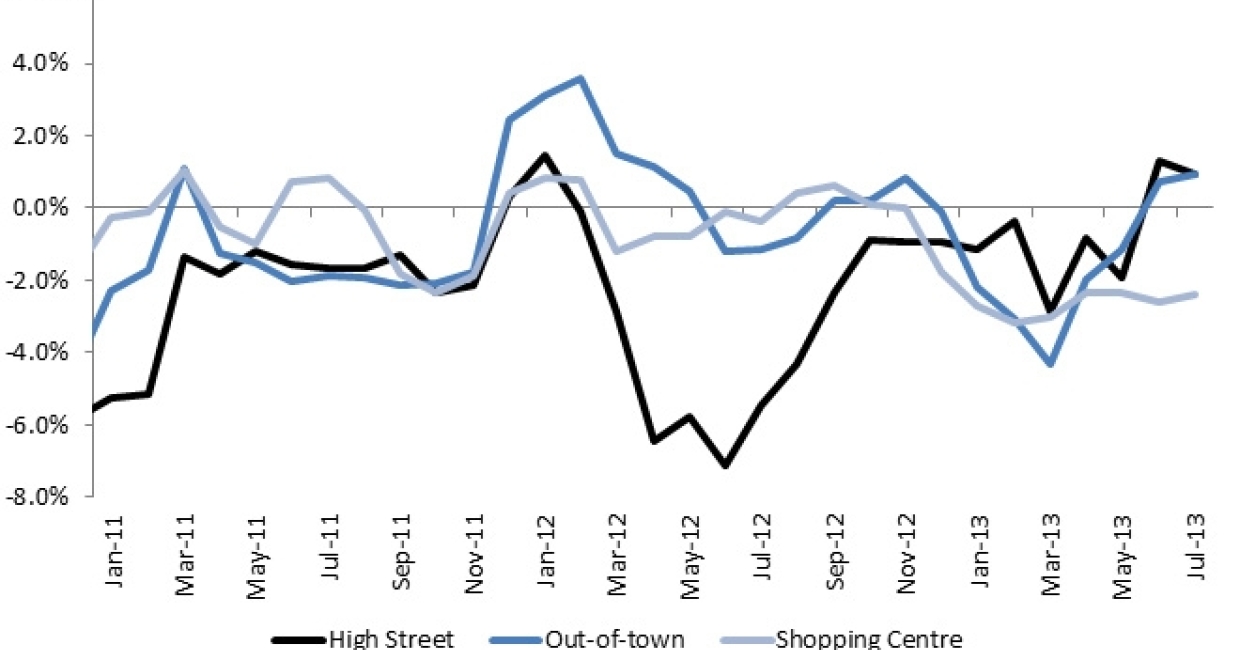Footfall in July was 0.8% higher than a year ago, an improvement on the 0.1% rise in June, reports the British Retail Consortium (BRC). This is the fourth month since the start of the year to report positive footfall growth. The warmer weather in July had a noticeable impact on the figures. High streets reported the greatest rise, up 2.3%, followed by out-of-town, 0.9%. Footfall in shopping centres fell 2.3% in July, an improvement on June’s 3.0% decline. In addition, the national town centre vacancy rate in the UK was 11.1% in July 2013, down from April’s high of 11.9%.
Helen Dickinson, director of the BRC, says: “It’s encouraging to see that the number of empty shops in the UK has fallen marginally since the record high of the previous quarter. But it’s still a stark statistic, which masks widespread variations - six parts of the UK had above average vacancy rates.
“There’s a little more cause for cheer on the footfall front, with the fourth positive result for high streets since the start of the year driving a decent increase overall. Taken together, these figures paint a mixed picture which further fuels our call this week for long term reform of business rates to help town centres across the UK. We’ve seen some cause for cautious optimism since the start of the year, but the path to recovery remains fragile. Bringing business rates into line with how town centres operate in the 21st century is a surefire way of offering retailers more certainty and scope to invest."
Diane Wehrle, Retail Insights Director at Springboard, said: “For the first time it seems that a longer term improvement in footfall trends might be emerging. Not only has footfall increased annually for the second month in a row, but the improvement in performance accelerated over the quarter, moving from a decline of -0.7% in May to an increase of 0.1% in June and 0.8% in July.
“Whilst the recent hot weather undoubtedly supported activity in high streets in July with an increase of 2.3%, the 1% uplift in footfall over the quarter is likely to have contributed to a drop in the vacancy rate from 11.9 per cent in April to 11.1 per cent in July. It seems that occupiers are starting to return to the high street, suggesting a greater degree of optimism over future trading prospects and lending further support to the proposition the performance of retail locations is stabilising.
“Of slight concern is that the increase in footfall is not occurring across all location types, but is concentrated in external environments (high streets and retail parks). Shopping centres recorded a significant decline in footfall of -2.4% over the quarter with a rate of decline that has increased from month to month, suggesting that covered malls are becoming less attractive retail destinations to shoppers.”
Two regions in England reported footfall significantly above the UK average - Greater London (4.8%) and the West Midlands (3.2%). Northern Ireland reported footfall above the UK average, up 3.0% in July. This was an improvement on June’s 5.9% decline and the first rise in footfall since February. Wales reported footfall in line with the UK average.
Four parts of the UK had a vacancy rate lower than the UK average - Greater London (7.0%), the South East (8.8%), Scotland (10.1%) and the East (10.1%). Northern Ireland and Wales reported the highest vacancy rates, but slowed from April’s rates. Northern Ireland fell marginally to 18.0% while Wales fell to 15.9% from 17.9% in April 2013.










